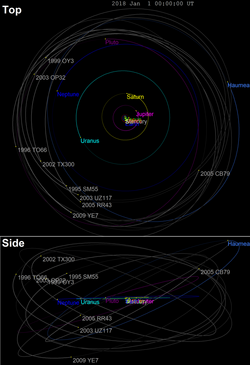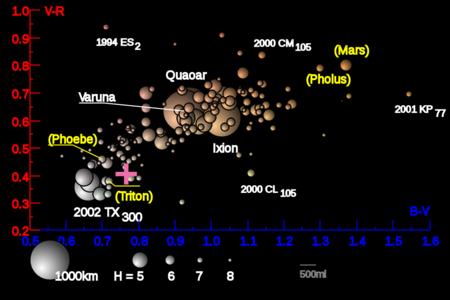Astronomy:(308193) 2005 CB79
From HandWiki
 (308193) 2005 CB79 among other Haumea family objects | |
| Discovery[1] | |
|---|---|
| Discovered by | M. E. Brown, C. A. Trujillo, D. L. Rabinowitz |
| Discovery date | 6 February 2005 |
| Designations | |
| 2005 CB79 | |
| Minor planet category | Cubewano (MPC)[2] Extended (DES)[3] |
| Orbital characteristics[5] | |
| Epoch 13 January 2016 (JD 2457400.5) | |
| Uncertainty parameter 4 | |
| Observation arc | 5083 days (13.92 yr) |
| |{{{apsis}}}|helion}} | 50.062 astronomical unit|AU (7.4892 Tm) (Q) |
| |{{{apsis}}}|helion}} | 37.231 AU (5.5697 Tm) (q) |
| 43.647 AU (6.5295 Tm) (a) | |
| Eccentricity | 0.14698 (e) |
| Orbital period | 288.36 yr (105324 d) |
| Mean anomaly | 319.66° (M) |
| Mean motion | 0° 0m 12.305s / day (n) |
| Inclination | 28.606° (i) |
| Longitude of ascending node | 112.79° (Ω) |
| |{{{apsis}}}|helion}} | ≈ 5 December 2048[4] ±3 days |
| 90.154° (ω) | |
| Physical characteristics | |
| Dimensions | 158 km[6][7] |
| Rotation period | 6.76 h (0.282 d) |
| Sidereal rotation period | 13.52 h[8] |
| Geometric albedo | 0.7 (assumed) |
| (Neutral) B-V=0.73, V-R=0.37[9] | |
| Apparent magnitude | 21.1[10] |
| Absolute magnitude (H) | 4.6[5] |
(308193) 2005 CB79 is a trans-Neptunian object that is a member of the Haumea family.[9]
Haumea family
As a member of the Haumea family, (308193) 2005 CB79 is suspected of being an icy mantle collisional fragment from dwarf planet Haumea. With an absolute magnitude (H) of 4.7,[5] and a Haumea-family albedo of 0.7, this object would have a diameter of 158 km.[7]
Observations by Mike Brown in 2012 using the W. M. Keck Observatory suggest that (308193) 2005 CB79 does not have a companion.[11]

The + marks 2005 RR43 (B-V=0.77, V-R=0.41) on this color plot of TNOs. All the other Haumea-family members (2005 CB79: 0.73, 0.37) are located to the lower left of this point.
References
- ↑ Marsden, Brian G. (September 1, 2007). "MPEC 2007-R02 : 2003 UY413, 2003 UZ413, 2004 NT33, 2005 CA79, 2005 CB79, 2005 UQ513". IAU Minor Planet Center. Harvard-Smithsonian Center for Astrophysics. http://www.cfa.harvard.edu/mpec/K07/K07R02.html.
- ↑ "MPEC 2010-A05 :Distant Minor Planets (14 January 2010.0 TT)". IAU Minor Planet Center. January 2, 2010. http://www.cfa.harvard.edu/mpec/K10/K10A05.html.
- ↑ Marc W. Buie (December 20, 2008). "Orbit Fit and Astrometric record for 308193". SwRI (Space Science Department). http://www.boulder.swri.edu/~buie/kbo/astrom/308193.html.
- ↑ JPL Horizons Observer Location: @sun (Perihelion occurs when deldot changes from negative to positive. Uncertainty in time of perihelion is 3-sigma.)
- ↑ 5.0 5.1 5.2 "JPL Small-Body Database Browser: (2005 CB79)". December 20, 2008. https://ssd.jpl.nasa.gov/sbdb.cgi?sstr=2005CB79.
- ↑ Assuming a Haumea-like albedo of 0.7
- ↑ 7.0 7.1 Dan Bruton. "Conversion of Absolute Magnitude to Diameter for Minor Planets". Department of Physics & Astronomy (Stephen F. Austin State University). http://www.physics.sfasu.edu/astro/asteroids/sizemagnitude.html.
- ↑ Carry, Benoit; Snodgrass, Colin; Lacerda, Pedro; Hainaut, Olivier; Dumas, Christophe (16 July 2012). "Characterisation of candidate members of (136108) Haumea's family: II. Follow-up observations". Astronomy & Astrophysics (EDP Sciences) 544: A137. doi:10.1051/0004-6361/201219044. Bibcode: 2012A&A...544A.137C. http://benoit.carry.free.fr/science/article/2012-AA-544-Carry.pdf. Retrieved 8 June 2014.
- ↑ 9.0 9.1 Snodgrass, Carry; Dumas, Hainaut (16 December 2009). "Characterisation of candidate members of (136108) Haumea's family". Astronomy and Astrophysics 511: A72. doi:10.1051/0004-6361/200913031. Bibcode: 2010A&A...511A..72S.
- ↑ "AstDys 2005CB79 Ephemerides". Department of Mathematics, University of Pisa, Italy. https://newton.spacedys.com/astdys/index.php?pc=1.1.3.0&n=2005CB79.
- ↑ Plutokiller (February 3, 2012). "2005 CB79 looks solitary.". Twitter. https://twitter.com/plutokiller/status/165421815693451265.
External links
 |


